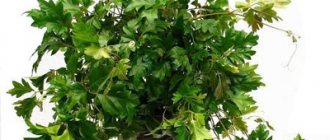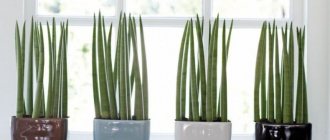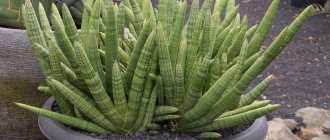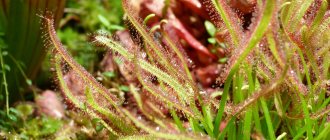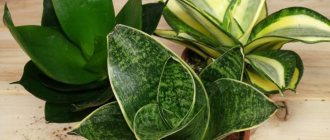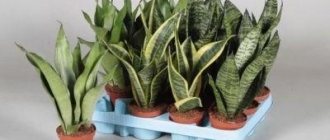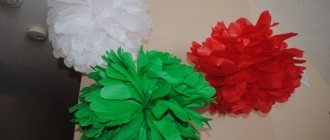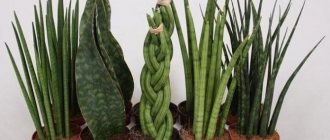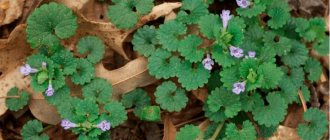Among indoor plants, only a few can compete with Sansevieria in terms of endurance. And no other favorite of “lazy” landscaping is distinguished by such strictness of form and purity of lines. Sansevieria is often perceived as a boring plant. But it’s worth looking at it from the other side and you can appreciate its classic appearance, versatility, and the ability to grow where other indoor plants cannot survive. Sansevieria can grow in almost any conditions! And it is suitable for both home and office, remaining the most reliable choice for a modern interior.
Sansevieria is an exceptionally hardy plant for interior decoration.
Signs related to energy
You always need to maintain energy balance in your home.
If you miss this, then the residents simply will not want to return to the house, and all guests will be scared away by the negative energy of your home. If you want to maintain the comfort of home, then you simply need to acquire a mother-in-law’s tongue. Mother-in-law's tongue will not require special care from you. It is quite easy and simple to care for. According to experts, it will be able to independently adapt to any living conditions. The only caveat is that you must feed it with negative energy. For him, ideal conditions are when there is a scandal in the house, a person is angry, or he is in a bad mood. Its main feature is that it takes away negative energy from guests and residents, and in return gives positive emotions. Its leaves act as an antenna that allows all these manipulations with a person’s mood.
Sansevieria helps its owner get rid of enemies. If you have a person at work who has a negative attitude towards you, then it is best to bring a pike tail to the workplace. Folk omens about the mother-in-law's tongue flower say that it will help you remove ill-wishers from your life and help you tune in to the work process.
How Sansevieria blooms (photo)
Flowering of sansevieria is rather rare, but with cool conditions in the spring, sometimes you are lucky. Clusters of inflorescences with cream flowers hide between the leaves and surprise with their strong aroma and lacy transparency.
Related article:
Zamioculcas (dollar tree) in the house: what the signs promise
Sansevieria hanni flowering
Sansevieria absorbs formaldehyde and toxic substances from the air and is one of the best filter crops.
Is it possible to keep Sansevieria at home?
Sansevieria (sansevieria)
There is an opinion that the plant is dangerous to keep at home. Actually this is not true. There is no scientific evidence to support the theory that it is dangerous for keeping at home. But there are scientific studies that prove the benefits of having a plant in an apartment.
Sansevieria affects gas exchange in the room and also saturates the air with negative oxygen ions. Thus, the air in the room becomes similar to the sea or forest. In addition, the flower absorbs harmful substances such as benzene. With the help of the plant, the influence of harmful substances from linoleum, chipboard and plastic is significantly reduced.
Whether to grow a plant in your home or not, everyone decides for themselves. But you definitely shouldn’t give up such a beautiful flower. After all, all beliefs and superstitions are nothing more than just myths and legends.
How can you fit a plant into the interior of an apartment?
With the correct placement of an indoor flower and the choice of a beautiful flowerpot, it can fit into any interior. The plant will look equally good on a windowsill, on bookshelves, shelving, on the floor and even in the bathroom. Everything depends only on the designer’s imagination.
Sansevieria in the interior: placement options and photos
Unpretentious houseplant
He doesn't care about the location in the house. When choosing a location, you should take into account the overall interior of the apartment.
Tall sansevieria will look impressive in a floor planter. The plant is erect and not spreading, which means it does not need much space. The pot may be low, then the plant should be chosen tall, and vice versa. The soil of the plant can be decorated with large stones or stone chips.
A low-growing plant is suitable as the basis of a flower arrangement. You can choose several types of one plant and combine them into similar, but separate pots.
Designers use a flower as an element of zoning a room: a rectangular partition leaves space for planting, and the soil is decorated with natural stones or sea pebbles.
Next you can see in the photo what the plant looks like in the interior:
In what cases is it not advisable to keep a culture at home?
There are no contraindications for keeping the plant in the house. The plant is dangerous if the leaves can be eaten by children or pets. Try to place the flower in a place inaccessible to children and animals who like to chew leaves.
How to care?
Caring for Sansevieria (Sansevieria) flowers at home, replanting, propagation
Caring for the cylinder at home is very simple. Even absolute beginners in gardening can cope with it, because the plant will survive both the only watering for a whole month and the absence of special procedures.
Top dressing
In principle, the cylinder can be grown without any fertilizing, but only in case of regular replanting, so that the plant does not find itself in a situation where all the nutrients in the soil have run out. However, in order to activate growth or avoid replanting, you can organize a fertilizer application system. This happens either once a month, or once every two weeks in the case of a dosage reduced by a couple of times.
Watering
Cylindrical Sansevieria prefers regular but infrequent irrigation. You can wait until the top layer of soil dries out before watering the plant. The cylinder is not afraid of dryness, but overwatering and waterlogging can be dangerous for it. If the soil mixture is selected correctly, watering can be carried out once every 4 weeks.
It is not necessary to spray the crop additionally, since dry air is not dangerous for it. However, you should clean the sheets of dust from time to time.
Disease Control
Although Sansevieria is immune to most common diseases, sometimes improper care can lead to symptoms of certain developmental disorders. For example, if the tips of the leaves dry out, this indicates that the plant is receiving too much water or is in too cold a place. The same care violations can lead to dark spots on the leaves themselves. In both situations, it is enough to simply normalize the irrigation system and move the bush to a warm place. A change in color to yellow is typical for sansevieria growing in a pot that is too small or without access to light rays.
Softening of the leaf at the base can result from liquid entering the center of the rosette and further development of a fungal disease. The fungus can be identified by the appearance of red spots with yellow edges.
Trimming
There is no need to form a cylinder. However, you will have to regularly trim damaged or diseased leaves. This is done using instruments that have been disinfected. If you want to create a weave yourself, you will have to choose young plants with densely growing soft leaves. Having formed a pigtail, it will need to be secured with soft twine or decorative twine. It is worth mentioning that if flowering occurs on each leaf, it is only once. Therefore, the already withered peduncle must be immediately eliminated.
Tips for growing and replanting sansevieria are waiting for you in the next video.
Home care
Ampelous bacopa: care, reproduction and preservation
Even a child can choose such an unpretentious indoor plant as Sansevieria.
Lighting
Good lighting is important only for variegated varieties of mother-in-law's tongue. It is recommended to place them on a southwestern or eastern window, where the color will appear especially brightly
If there is no suitable place, then you can safely grow plain varieties in the back of the room or on the north window.
It is recommended to move them closer to the light for at least 1–2 months a year or take them outside in the summer. During this time, a pair of new leaves are formed, which grow under the same conditions.
Temperature
Sansevieria adapts to a fairly wide range of temperatures - from 16 to 25 ° C
In summer, at higher temperatures, the pike tail will easily tolerate the heat and will not require additional attention. Important! In winter, the temperature should not be allowed to drop to 10 ° C, which will lead to frostbite of the roots and their rotting. The pike tail is able to develop at a constant temperature all year round. You will only need to create special conditions for wintering if you want to see how Sansevieria blooms
For this purpose, the temperature is reduced to 15 °C for 1 month.
How to water a pike tail
Mother-in-law's tongue gets along well with those who often forget to water the flowers. The hard leaves of Sansevieria just like it - even in summer you should not water the plant more than once a week.
In winter, you can moisten the soil only once a month, thereby reducing the ambient temperature.
Watering too frequently can cause rotting of the root system and the death of your pet. It is recommended to focus on the soil: it must dry completely to its entire depth.
Important! When watering, be sure to ensure that water does not get into the center of the outlet. Moisture will very quickly cause leaves to turn black and die
Humidity
One of the many advantages of keeping pike tail is that you don’t need to spray the leaves. The procedure can even harm the sockets if moisture flows into their base. For hygienic purposes, you can only wipe the leaves with a damp cloth, removing dust from them.
How to replant sansevieria
Although pike tail grows slowly, you should know how to replant sansevieria at home. A wide pot is selected for replanting, since the roots of the flower grow more to the sides than to the depth. In this case, the material from which the container is made is not important - plastic and clay flowerpots are acceptable.
Advice! For tall sansevieria, it is better to choose a heavy ceramic pot that will not tip over from overgrown foliage.
It is better to prepare the soil yourself from equal parts of leaf soil, turf soil and sand. The finished composition should be loose and highly nutritious. Of the ready-made substrates, pike tail is suitable for soil for succulents or cacti.
Relocation to a new pot is carried out using the transfer method:
- Water the plant for better extraction.
- Fill the new pot one-third full with drainage, with a layer of soil on top.
- Turn the pike tail over, holding it by the base, and shake it out of the pot.
- Remove softened or broken roots and dust the damaged area with charcoal.
- Place the plant in the center of the new pot and cover it with soil.
Sansevieria fertilizer
The recently transplanted mother-in-law's tongue does not need fertilizer for a long time. Fertilizing can be applied when the flower has been kept in the same substrate for more than six months or begins to wither.
Advice! Add additives only during the active growth phase in good lighting conditions. In partial shade, without the formation of new leaves, nutrients will not be absorbed and will only lead to a chemical burn of the roots.
You should water the flower with fertilizer no more than once a month, and fertilizers for succulents are best suited for this.
Diseases and pests
The occurrence of pests and diseases is often unpredictable. Suddenly the leaves become torn and are susceptible to insect bites. In open ground, this is usually a snail, which is very fond of sansevieria. The activity of this creature wakes up at night, if the situation is like this, then the beauty of the plant becomes no longer visible. Most pests are visible to the naked eye, others can only be seen with a magnifying glass.
The main pests that attack the flower are mealy mites and spider mites. They feed on the plant by sucking the juice from the leaves. This, in turn, causes wilting and possible shrinkage if the problem is not addressed in time. They also harm sansevieria, making it more susceptible to diseases and other pests.
If you treat the foliage with alcohol, the mites will disappear. High humidity also helps, but this process must be strictly controlled, since it can harm the flower.
Pests are easier to eliminate than diseases. Plant growers use several methods to combat both. The first is mechanical or manual, the second is using chemical and biological means of protection. Each method has its own advantages and disadvantages. Depending on the scale of planting, they have a certain level of efficiency.
Diseases that affect sansevieria are usually isolated, but they are difficult to overcome. The damage is dealt quickly and powerfully. Pathogenic organisms are not only fungi, but also bacteria and viruses. These organisms usually cooperate with others called vectors. For prevention, a fungicide or bactericide is needed before planting seeds.
The best way for plant lovers to avoid pests is to use appropriate, sterile planting material. Regular spraying of pesticides is very effective in eradicating pests.
Sansevieria is mainly affected by fungal diseases, which, in turn, arise due to the presence of moisture on the leaves. Reddish-brown pinpoint lesions appear on the leaves. White spider-like growths may be visible, which later turn brown and harden. The grower must take preventive measures: leaves should remain dry, proper watering, good drainage.
Swollen, smelly leaves are the result of overwatering or overwatering . Excess water causes plant cells inside the leaves to explode, causing swelling and odor. It is necessary to remove the affected shoots and normalize the watering plan.
Brown leaves are a sign that the plant, on the contrary, lacks moisture . Brown tips may indicate inconsistent watering. You should not remove them, as this leads to scarring of the plant. Instead, it is better to follow a watering schedule and let the flower recover on its own.
Scarring is caused by too frequent contact with foliage by children and animals. In this case, scars will be inevitable, in addition, any rough handling causes the appearance of a scar.
Rot at the base - usually appears in winter from watering too often . No treatment will help in this case; if all the leaves have signs of rot, then the plant cannot be saved, but you can try cutting the cuttings and propagating the flower again.
Red spotting spreads to the new leaves of the bushes, which are located in the center . The infection appears and spreads when it is humid, since this is the environment most favorable for spores. The lesions have an uneven shape, red-brown color, with a yellow edging. In conditions of high incidence, the infection spreads very quickly. If the bush is treated with a fungicide, growth in the center may resume, often with several buds.
Prevention of the disease comes down to keeping the foliage dry. If this is not possible, it is worth using one of the available fungicides to reduce symptoms.
Southern late blight is a pathogen that attacks the entire plant without exception, but can most often be seen on the foliage. The first symptoms are similar to necrotic lesions near the ground line . The white mycelium has a dense structure, grows in a fan-shaped form and can be seen on the ground or leaves.
The affected areas are round in shape and initially white and about the size of a mustard seed. Then they acquire a dark brown color and harden. The mycelium and sclerotia grow simultaneously with rot and wilting of the stem.
Root nematode - can always be seen on the root . Stunted growth and wilting of the plant accompany the problem during the development phase with severe infection. As a means of prevention, it is worth using sterile soil.
The main arthropod pests of this plant species include moths (worms) and thrips.
Infestation by caterpillars is easy to detect because the worms and their excrement are usually clearly visible to the naked eye. The damage appears as holes inside the center or along the edges of the leaves. Often confused with snail infestation.
The only way to determine which pest is involved in the infestation is to find a sample.
Thrips are small insects; as adults they can be identified by the long fringe around both pairs of wings. Infected leaves become curled or distorted, with silvery-gray lines or calloused areas. Thrips can additionally transmit a virus that affects ornamental plants.
Landing
Sansevieria can be grown not only indoors, but also in open ground, since it is very resistant to low temperatures. The main thing that is required from the grower is good drainage, since this species does not like large amounts of moisture.
The ability to withstand drought well has made the plant popular in arid areas as the main decoration of the landscape.
Sansevieria prefers full sun, but will grow successfully in light to moderate shade. However, some species with colored colors may not develop them if not given enough sun, meaning the leaves will remain just green without any gold edging. Moreover, too little light will result in weak growth and small bushes.
Over time, if the grower has chosen the planting site correctly, the plant begins to fill everything around it. In this case, there are three ways to deal with the problem:
- you can dig up shoots every 2-3 years;
- it is necessary to plant sansevieria in containers, which are then placed in the ground, thus they remain out of sight, preventing growth;
- install barriers several tens of centimeters into the ground, which prevent root growth.
The time for planting in the soil is early spring. This flower has no special requirements regarding the quality and fertility of the soil, so it does not require much attention. A small depression is made in the ground into which the bush is placed so as to cover the root collar with soil. The first watering is carried out, then the soil around is moistened no more than once a week and lightly.
Most amateurs and professionals grow sansevieria as a houseplant. She adapts perfectly to indoor life. It is best to place the pot in a sunny place, but even a room with little light is suitable.
For planting, you can use cactus potting soil or add coarse sand to regular sand to provide the quality drainage these plants need.
Some types of plants grow quickly, so they will need to be divided annually. For planting, you should use a container that is shallow but wide. The bushes have a shallow root system, but it grows well. The soil at the bottom of a deeper container retains moisture longer, which leads to root rot.
Replanting is done in the spring, at the same time you can fertilize the plant using a balanced composition (10-10-10 or 8-8-8). The second time, fertilizing is applied closer to the end of the growing season, that is, in August. The plant should not be fertilized in winter.
Place and lighting
The plant feels good both on the sunny side and in the shade. It can be placed in any room, placed on a windowsill or on a shelf in the back of the room.
But you need to remember that in bright light the leaves acquire a more contrasting color and the flower looks more interesting. In addition, the plant will not bloom in a dark place.
In the warm season, it is recommended to keep sansevieria on a loggia or covered terrace. There she can stay until autumn, until the nights become cold.
Description of the plant
Sansevieria cylindrical differs from other representatives of its genus by its leaves twisted into a tube, growing directly from the ground.
Thanks to careful selection, it was possible to develop several varieties of this plant, which differ in the thickness and height of the leaf blades, location, shape and color of the stripes on them.
Among the most popular are Sansevieria Mikado, Spike, Spaghetti and Twister. The latter variety is unique in that its leaves retain the ability to bend, thanks to which the flower can be shaped like a braid.
Sansevieria cylindrical grows up to one and a half meters in height. The dark green leathery leaves have a pronounced longitudinal groove, and at the tip there is a point, which often dries out, turning into a thorn.
Light spots on the leaves form the typical striping pattern for the species. Depending on the variety, such spots can be wide or narrow. They also differ in shades: some have tones similar to the main color, while others contrast with it.
During flowering, Sansevieria cylindrica produces a peduncle, the length of which can reach 1 meter. White tubular flowers with pinkish tips are located evenly on it, in the form of a spike or a brush elongated along the length. Depending on the variety, the color of the peduncle itself can be light green, bright green or beige-pink.
Botanical description of the genus Sansevieria or Sansevieria
The genus Sansevieria are succulents that, at home, can reach up to 1 meter. If you provide the plant with proper care, it will delight you with flowering. In home floriculture, the crop is valued for its original leaves, which form into rosettes. Most of them develop directly from the rhizome. Certain species have a stem.
Photo of Sansevieria succulent in natural conditions
The leaves have a dark green tint; certain species are brown in color and have longitudinal or transverse stripes. They are usually yellow or white in color. Sometimes there are leaves with a waxy coating, like those of Agave or Aloe. The shape of the leaves is wide, flat and oblong. Sometimes there are original forms - pencil-shaped, urinary or spoon-shaped. The Sansevieria plant, which is most often grown at home, usually grows upward in a vertical direction. But there are also those specimens that have leaves oriented in different directions. The tips may be pointed; they are not allowed to be broken, since this only makes the culture begin to develop worse.
Each Sansevieria succulent develops differently. The intensity of its growth largely depends directly on the individual characteristics of the species. There are many fast-growing specimens, but there are also those that produce only 4 new leaves per year.
To stimulate the flowering of Sansevieria, it is necessary to perform a special procedure. First, place the culture in a shady and preferably cool place. Be sure to limit watering. Then move it to normal conditions in a sunny area.
Home care
If the plant is grown or transplanted at home, then it is worth placing it in a place where there is moderately bright or diffused light for as long as possible. The position in front of the north window can be considered good. Although the plant tolerates the absence of light well, it helps to bring out the color on the leaves.
Be sure to let the soil dry completely before watering, and then wet it well until water flows through the drainage holes. The pot must drain before it is placed on the saucer. The soil should not be allowed to remain damp for a long time; watering is reduced to a minimum in winter.
The flower is valued for its interesting appearance. Although the most common variety is known as Mother-in-law's Tongue, other equally attractive varieties can be found on windows. Other varieties grow into compact rosettes and reach a height of up to 10 cm. Even with minimal care, this plant lives and pleases for many years, and sometimes seems almost invulnerable. Sansevieria is suitable for planting outdoors.
It is better to replant the flower and feed it once every 3 weeks throughout the summer. Too much fertilizer causes the leaves to start falling off. When there is flowering on the plant, it is worth caring for more carefully, watering it on time and wiping off the dust with a soft damp cloth. If any shoots are damaged or spoiled, they are cut off from the root. Planting a flower means acting very carefully so as not to damage the roots.
Several species of weeds are also serious pests in field flower growing conditions. The leaves need sufficient light, so taller plants should not develop around them. This also applies to grass. Research has shown that herbicides are quite effective in combating this problem, but they can also harm sansevieria.
Types and varieties of sansevieria (photo)
Sansevieria has quite a lot of decorative varieties, the easiest way to distinguish them is by the type of leaves - shortened, xiphoid or fleshy-thickened.
Sansevieria trifasciata
Three-lane Sansevieria (Sansevieria trifasciata) - the same pike or mother-in-law's tongue. Its unusualness is already evident in the thick, powerful roots creeping to the side, often tearing the containers. The leaves of this species are tall, up to 1 m, grow straight, very hard, covered with uneven dark streaks and stripes. Ordinary sansevieria have long been supplanted by forms and varieties with beautiful stripes along the edges of the leaves - most often light yellow.
Related article:
5 natural fertilizers for home flowers
Sansevieria hahnii
Sansevieria hannii (Sansevieria hahnii) is a variety of three-lane Sansevieria, but is increasingly appearing as an independent species. It stands out with flower-shaped rosettes with triangular, shortened leaves, decorated with light light green-silver stripes.
Sansevieria cylindrica Sansevieria
cylindrica is a very fashionable species that surprises with the effect of green sculpture. The round, cylindrical stems grow straight or are specially intertwined into braids and appear as artificial waxy bluish-green sticks. Thanks to its slow growth, extreme resistance to shade, and compactness (height up to 40 cm), the cylindrical plant looks a little alien, especially if several plants are planted together to obtain dense clumps.
Sansevieria pinguicula
Sansevieria pinguicula looks more like a variety of aloe, so unusual are its fleshy, succulent leaves with pointed edges, sticking out in the rosette like exotic teeth.
Sansevieria kirkii
Sansevieria kirkii an unusual species with wavy, pink-edged, lightly speckled sword-shaped leaves in a rosette spreading along the ground. The red spheres of the inflorescences are very original.
Hyacinth Sansevieria (Sansevieria hyacinthoides)
Hyacinth Sansevieria (Sansevieria hyacinthoides) is an unusual species with numerous rosettes of 3-4 narrow, twisting, silver-green leaves, forming peculiar thickets with tall fluffy spikelets of inflorescences. Old leaves almost spread out over the soil over time.
Graceful Sansevieria (Sansevieria gracilis)
Graceful Sansevieria (Sansevieria gracilis) also looks like a hybrid of aloe and sansevieria. Decorated with stripes, bright narrow leaves up to 30 cm long at the tops are rolled into a tube, and from a distance they appear round in cross-section. The rosettes are uneven, the leaves stick out in all directions.
Sansevieria propagation
Three methods are used to propagate sansevieria:
- growing from seeds;
- root division;
- use of cuttings.
The first method is practically not used due to the difficulty of obtaining seeds, because the plant blooms extremely rarely. If you still managed to get sansevieria fruits, the seeds are taken out of the berries and dried. Then they are sown on a sterile, slightly moist substrate. It is recommended to cover the container with the seeds with film and place it in a warm place. Here, flower growers face new difficulties, since sprouts often develop poorly or can simply rot in the soil if the humidity is excessive. Daily ventilation is necessary.
Dividing Sansevieria rhizomes
There are much simpler and more reliable methods of reproduction. One of them is dividing the rhizome, which is convenient to do during transplantation. A young Sansevieria will grow completely identical to the mother plant.
Procedure:
- Cut the rhizome with a sharp, disinfected knife into pieces, each of which should have leaves and roots. Make sure that in Sansevieria species with formed rosettes, each individual part has a rosette;
- The resulting parts are planted in pots with substrate and kept at a temperature of at least 20°C until they take new roots. When new leaves appear, it means that the roots are already well developed.
Important! The cut surfaces are treated with charcoal to avoid fungal infections. In addition to cutting the rhizome, you can separate the resulting side shoots or daughter rosettes
They must have leaves at least 5 cm long and first roots
In addition to cutting the rhizome, you can separate the resulting side shoots or daughter rosettes. They must have leaves at least 5 cm long and first roots.
How to root sansevieria without roots
The most popular propagation method for this is rooting cuttings from leaves.
Procedure:
The leaf of the mother plant is separated with a sterile knife near the surface of the soil. If it is small, you can use the whole one; long leaves are cut into several pieces no less than 5 cm long; The cuttings are dried for several days, and the cut, which will be immersed in the soil, is treated with Kornevin to stimulate root growth
For leaves cut into several parts, you need to pay attention to the direction of growth, otherwise the cutting will not be able to root. Plant pieces of leaf in the ground, deepening them by 1.5-2 cm. At the next stage, you need to know how to care for sansevieria, its leaf cuttings
The substrate where planting is carried out should be moist, but not wet. It is constantly maintained in this state; The container with cuttings is placed in a warm, bright place at a temperature of at least 20°C. It is better if it is around 25°C. You can cover the top with film, but do not forget about ventilation. Patience will be required. It may take more than a month before the first shoots appear; As soon as the sprouts appear on the surface, the leaf cutting itself can be removed and after a couple of months the young plants can be planted in separate containers.
Rooting leaf cuttings
Important! In offspring propagated in this way, the color of the leaves will turn green, and the variegation of color will disappear if it was present in the mother plant
Possible difficulties
Sansevieria may experience the following problems: - Rotting of the base of the leaves and rhizomes. - Yellowing of leaves. - Appearance of dry ends. - The appearance of pests.
If the leaves begin to soften or the rhizomes rot, it means that the watering is too abundant. In order to save the plant, it should be removed from the container, the diseased parts should be removed, the sections should be sprinkled with activated carbon and the specimen should be planted in new soil. In advanced cases, it will be necessary to restore Sansevieria by propagating and separating healthy shoots.
Sansevieria photo:
Rotting of the root neck can also occur with prolonged hypothermia, so do not allow the temperature to drop below 12 degrees. Sansevieria sometimes develops brown spots that spread from top to bottom. The disease is not infectious; you can maintain a decorative appearance by carefully trimming the ends.
Sansevieria is an ideal plant for interior decoration. For its ease of care and beautiful leaf shape, it is loved not only by flower growers, but also by designers.
Caring for Sansevieria at home
Each plant has its own characteristics, as well as advantages and disadvantages. Before you decide to decorate your home with this or that flower, first try to find out in more detail how to care for it and what it needs for normal development and growth. And then think about whether you can grow it or not.
The pike tail differs from many other indoor plants in that it is not demanding in care and at the same time has a spectacular appearance. Features of cultivation:
- Sansevieria is fed very rarely, only once a year. However, if feeding is more frequent, the flower will react positively to this.
- It feels best on a windowsill because it needs plenty of natural light. At the same time, it can be both cool and warm on the windowsill.
- The midday scorching rays of the sun can leave burns on the foliage; therefore, windows that receive direct sunlight only in the late afternoon are ideal for growing pike tail.
- Regular stagnation of water in the root system can destroy a flower.
Temperature and humidity
For a plant, it doesn’t really matter what the temperature and humidity in the room are. But at the same time, you should not allow the room to be cooler than 16 degrees during the cold season, as this will negatively affect the appearance of the bush. Also, to preserve its decorative appearance, do not forget to systematically wipe the foliage with a damp sponge, which will remove dust from it.
Watering
In order for sansevieria to grow and develop normally, it must be properly watered. To understand when to water a flower, you can purchase a humidity indicator at a specialty store. Distilled or rainwater is best suited for watering a flower, but you can also use well-settled tap water. It must be at room temperature. In winter, the frequency of watering depends on the air temperature in the room: the colder the room, the less often you need to moisten the substrate in the pot.
Sansevieria transplant
The pike tail is replanted if necessary, when the root system completely fills the flower pot. On average, young bushes undergo this procedure once every 2 years, and adults - once every 3 years. Replanting sansevieria is easy, but do not forget to prepare the correct soil mixture for this. It is not recommended to use ordinary garden soil for this; a ready-made soil mixture sold in a specialized store is best suited for replanting. Its approximate composition should be: turf and leaf soil, as well as sand (2:1:1). The purchased ready-made soil mixture may also contain fine gravel and perlite.
Transplantation is carried out only when roots appear from the drainage holes. This means that the root system is very crowded in the pot. A suitable flower pot should have thick walls, preferably clay. The fact is that a powerful root system can tear thin walls, and long, heavy foliage can overturn a light pot. Also, a container suitable for transplantation should not be very high, but quite wide. Don't forget to make a good drainage layer at the bottom of the pot.
Top dressing
Pike tail needs to be fed only in spring and summer once every 30 days. Liquid mineral fertilizer for cacti or decorative deciduous crops is well suited for this. Do not add too much nitrogen to the substrate, as this may harm the flower. Experts advise using a nutrient mixture whose concentration is two times weaker than that recommended by the manufacturer (see instructions). If you are growing a species that has a pattern on the foliage, then the fertilizer concentration should be three times less than that recommended by the manufacturer. If you feed it with a more saturated solution, then because of this the foliage may become monochromatic.
